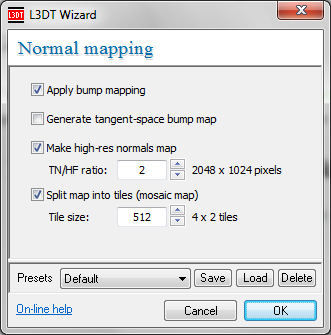|
Table of Contents
Terrain normals operationsGenerating the normals mapThe normals map is required to calculate the light map. To calculate the normals, click on the 'Operations→Terrain normals→Generate map' option in the menu. This operation will invalidate the light map and texture map, and will only be greyed-out if no heightfield is loaded. The 'normal mapping' wizardIf you are using L3DT Professional, you get hit with an extra wizard pane for normal mapping: The controls are as follows: Apply bump-mappingWith apply bump mapping enabled, L3DT will combine the bump maps of the land types in the attributes map directly with the terrain normal map. This option is usually not enabled. Instead, bump-mapping is typically applied procedurally during the light-mapping calculation (via the light-mapping wizard), as this provides the maximum bump-mapping detail. However, if you wish to do your own light-mapping in another program (e.g. in a 3D renderer), then you might want to use this option to take advantage of L3DT's bump-mapping routine. Generate tangent-space bump mapThis option will generate a second terrain normals map layer, called “TN-Tangent”, which contains the terrain normal vectors in the heightfield tangent space. These tangent space normal maps are not used in L3DT, but may be useful in some game engines / renderers. Make high-res terrain normalsThe make high-res terrain normals option allows you to generate the normal map at a higher resolution than the heightfield. The desired ratio of the normals map size to the heightfield size is given by the TN/HF ratio. This option is normally used when applying bump-mapping to the normals map for lighting/rendering in another program (see above). High-res normals are not required in L3DT, as they are generated procedurally when making the light map. Split map into tilesThe split map into tiles option allows you to split the normal map into a mosaic map, which reduces the amount of RAM used during calculations. The side-length of each tile (which are always square) is given by the tile size number. Large values increase your RAM-load, whilst smaller values increase your disk read/write load. A value of 512 is typical. Except where otherwise noted, content on this wiki is licensed under the following license:CC Attribution-Share Alike 3.0 Unported
|

